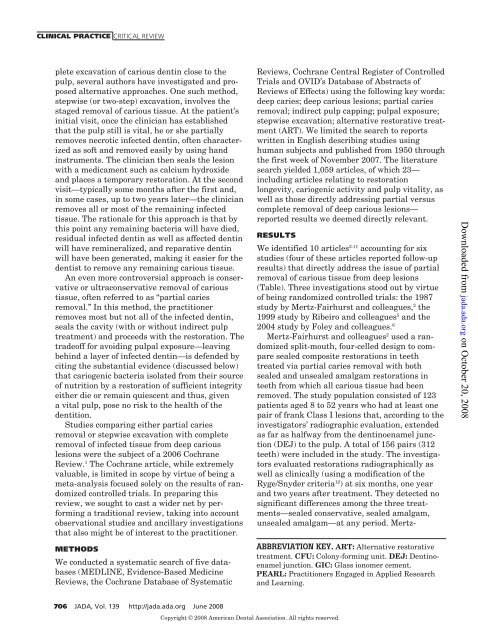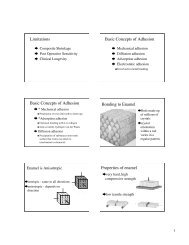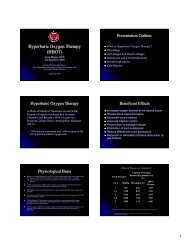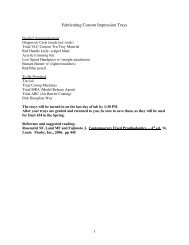Management of the deep carious lesion and the - Ohio State ...
Management of the deep carious lesion and the - Ohio State ...
Management of the deep carious lesion and the - Ohio State ...
You also want an ePaper? Increase the reach of your titles
YUMPU automatically turns print PDFs into web optimized ePapers that Google loves.
CLINICAL PRACTICE CRITICAL REVIEW<br />
plete excavation <strong>of</strong> <strong>carious</strong> dentin close to <strong>the</strong><br />
pulp, several authors have investigated <strong>and</strong> proposed<br />
alternative approaches. One such method,<br />
stepwise (or two-step) excavation, involves <strong>the</strong><br />
staged removal <strong>of</strong> <strong>carious</strong> tissue. At <strong>the</strong> patient’s<br />
initial visit, once <strong>the</strong> clinician has established<br />
that <strong>the</strong> pulp still is vital, he or she partially<br />
removes necrotic infected dentin, <strong>of</strong>ten characterized<br />
as s<strong>of</strong>t <strong>and</strong> removed easily by using h<strong>and</strong><br />
instruments. The clinician <strong>the</strong>n seals <strong>the</strong> <strong>lesion</strong><br />
with a medicament such as calcium hydroxide<br />
<strong>and</strong> places a temporary restoration. At <strong>the</strong> second<br />
visit—typically some months after <strong>the</strong> first <strong>and</strong>,<br />
in some cases, up to two years later—<strong>the</strong> clinician<br />
removes all or most <strong>of</strong> <strong>the</strong> remaining infected<br />
tissue. The rationale for this approach is that by<br />
this point any remaining bacteria will have died,<br />
residual infected dentin as well as affected dentin<br />
will have remineralized, <strong>and</strong> reparative dentin<br />
will have been generated, making it easier for <strong>the</strong><br />
dentist to remove any remaining <strong>carious</strong> tissue.<br />
An even more controversial approach is conservative<br />
or ultraconservative removal <strong>of</strong> <strong>carious</strong><br />
tissue, <strong>of</strong>ten referred to as “partial caries<br />
removal.” In this method, <strong>the</strong> practitioner<br />
removes most but not all <strong>of</strong> <strong>the</strong> infected dentin,<br />
seals <strong>the</strong> cavity (with or without indirect pulp<br />
treatment) <strong>and</strong> proceeds with <strong>the</strong> restoration. The<br />
trade<strong>of</strong>f for avoiding pulpal exposure—leaving<br />
behind a layer <strong>of</strong> infected dentin—is defended by<br />
citing <strong>the</strong> substantial evidence (discussed below)<br />
that cariogenic bacteria isolated from <strong>the</strong>ir source<br />
<strong>of</strong> nutrition by a restoration <strong>of</strong> sufficient integrity<br />
ei<strong>the</strong>r die or remain quiescent <strong>and</strong> thus, given<br />
a vital pulp, pose no risk to <strong>the</strong> health <strong>of</strong> <strong>the</strong><br />
dentition.<br />
Studies comparing ei<strong>the</strong>r partial caries<br />
removal or stepwise excavation with complete<br />
removal <strong>of</strong> infected tissue from <strong>deep</strong> <strong>carious</strong><br />
<strong>lesion</strong>s were <strong>the</strong> subject <strong>of</strong> a 2006 Cochrane<br />
Review. 1 The Cochrane article, while extremely<br />
valuable, is limited in scope by virtue <strong>of</strong> being a<br />
meta-analysis focused solely on <strong>the</strong> results <strong>of</strong> r<strong>and</strong>omized<br />
controlled trials. In preparing this<br />
review, we sought to cast a wider net by performing<br />
a traditional review, taking into account<br />
observational studies <strong>and</strong> ancillary investigations<br />
that also might be <strong>of</strong> interest to <strong>the</strong> practitioner.<br />
METHODS<br />
We conducted a systematic search <strong>of</strong> five databases<br />
(MEDLINE, Evidence-Based Medicine<br />
Reviews, <strong>the</strong> Cochrane Database <strong>of</strong> Systematic<br />
706 JADA, Vol. 139 http://jada.ada.org June 2008<br />
Copyright © 2008 American Dental Association. All rights reserved.<br />
Reviews, Cochrane Central Register <strong>of</strong> Controlled<br />
Trials <strong>and</strong> OVID’s Database <strong>of</strong> Abstracts <strong>of</strong><br />
Reviews <strong>of</strong> Effects) using <strong>the</strong> following key words:<br />
<strong>deep</strong> caries; <strong>deep</strong> <strong>carious</strong> <strong>lesion</strong>s; partial caries<br />
removal; indirect pulp capping; pulpal exposure;<br />
stepwise excavation; alternative restorative treatment<br />
(ART). We limited <strong>the</strong> search to reports<br />
written in English describing studies using<br />
human subjects <strong>and</strong> published from 1950 through<br />
<strong>the</strong> first week <strong>of</strong> November 2007. The literature<br />
search yielded 1,059 articles, <strong>of</strong> which 23—<br />
including articles relating to restoration<br />
longevity, cariogenic activity <strong>and</strong> pulp vitality, as<br />
well as those directly addressing partial versus<br />
complete removal <strong>of</strong> <strong>deep</strong> <strong>carious</strong> <strong>lesion</strong>s—<br />
reported results we deemed directly relevant.<br />
RESULTS<br />
We identified 10 articles2-11 accounting for six<br />
studies (four <strong>of</strong> <strong>the</strong>se articles reported follow-up<br />
results) that directly address <strong>the</strong> issue <strong>of</strong> partial<br />
removal <strong>of</strong> <strong>carious</strong> tissue from <strong>deep</strong> <strong>lesion</strong>s<br />
(Table). Three investigations stood out by virtue<br />
<strong>of</strong> being r<strong>and</strong>omized controlled trials: <strong>the</strong> 1987<br />
study by Mertz-Fairhurst <strong>and</strong> colleagues, 2 <strong>the</strong><br />
1999 study by Ribeiro <strong>and</strong> colleagues5 <strong>and</strong> <strong>the</strong><br />
2004 study by Foley <strong>and</strong> colleagues. 6<br />
Mertz-Fairhurst <strong>and</strong> colleagues2 used a r<strong>and</strong>omized<br />
split-mouth, four-celled design to compare<br />
sealed composite restorations in teeth<br />
treated via partial caries removal with both<br />
sealed <strong>and</strong> unsealed amalgam restorations in<br />
teeth from which all <strong>carious</strong> tissue had been<br />
removed. The study population consisted <strong>of</strong> 123<br />
patients aged 8 to 52 years who had at least one<br />
pair <strong>of</strong> frank Class I <strong>lesion</strong>s that, according to <strong>the</strong><br />
investigators’ radiographic evaluation, extended<br />
as far as halfway from <strong>the</strong> dentinoenamel junction<br />
(DEJ) to <strong>the</strong> pulp. A total <strong>of</strong> 156 pairs (312<br />
teeth) were included in <strong>the</strong> study. The investigators<br />
evaluated restorations radiographically as<br />
well as clinically (using a modification <strong>of</strong> <strong>the</strong><br />
Ryge/Snyder criteria12 ) at six months, one year<br />
<strong>and</strong> two years after treatment. They detected no<br />
significant differences among <strong>the</strong> three treatments—sealed<br />
conservative, sealed amalgam,<br />
unsealed amalgam—at any period. Mertz-<br />
ABBREVIATION KEY. ART: Alternative restorative<br />
treatment. CFU: Colony-forming unit. DEJ: Dentinoenamel<br />
junction. GIC: Glass ionomer cement.<br />
PEARL: Practitioners Engaged in Applied Research<br />
<strong>and</strong> Learning.<br />
Downloaded from<br />
jada.ada.org<br />
on October 20, 2008






